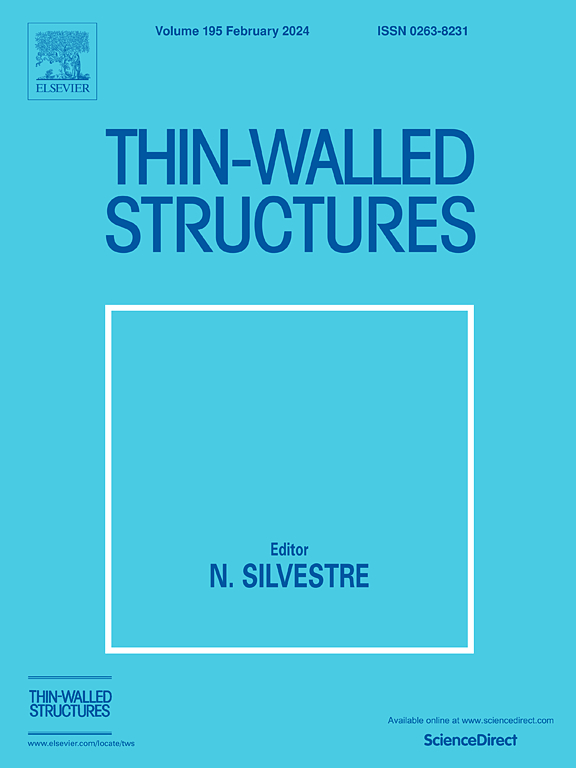钢-混凝土-钢-梯度泡沫铝吸能板的冲击响应:实验和数值研究
IF 5.7
1区 工程技术
Q1 ENGINEERING, CIVIL
引用次数: 0
摘要
为提高现有结构的抗冲击性能,提出了一种新型钢-混凝土-钢-梯度铝泡沫吸能板(SCSGF-EAP)。通过落重冲击试验和数值模拟评估了 SCSGF-EAP 的抗冲击性能。在落锤冲击试验中考虑了不同厚度的梯度铝泡沫和混凝土芯材。所有试样都呈现出一致的破坏模式,包括 SCS 面板的局部压痕和整体弯曲以及梯度铝泡沫的破碎。为研究 SCSGF-EAP 的抗冲击性能,采用 LS-DYNA 建立了有限元(FE)模型。数值模型确定了试样不同成分的内能,梯度铝泡沫吸收了大部分冲击能量。最后,通过参数研究确定了冲击器的初始动量和动能以及梯度铝泡沫的密度和冲击位置对 SCSGF-EAP 冲击响应的影响。本文章由计算机程序翻译,如有差异,请以英文原文为准。
Impact responses of steel–concrete–steel–gradient aluminum foam energy absorbing panels: Experimental and numerical studies
A novel steel–concrete–steel–gradient aluminum foam energy absorbing panel (SCSGF-EAP) has been proposed for improving the impact resistance of existing structures. The impact resistant performances of the SCSGF-EAP were evaluated through the drop weight impact tests and numerical simulations. The varying thickness of gradient aluminum foam and concrete core was considered in the drop weight impact tests. All the specimens presented a consistent failure mode, which included local indentation and global flexure of SCS panel and crushing of gradient aluminum foam. The Finite Element (FE) model was developed through adopting LS-DYNA for studying the impact resistance of SCSGF-EAP, and the comparisons exhibited that numerical results agreed well with experimental data. The internal energy of different components of specimen was determined by numerical model, and the gradient aluminum foam absorbed the majority of the impact energy. Finally, parametric studies were adopted to determine influences of the initial momentum and kinetic energy of impactor, as well as the density of gradient aluminum foam and impact location on the impact response of SCSGF-EAP.
求助全文
通过发布文献求助,成功后即可免费获取论文全文。
去求助
来源期刊

Thin-Walled Structures
工程技术-工程:土木
CiteScore
9.60
自引率
20.30%
发文量
801
审稿时长
66 days
期刊介绍:
Thin-walled structures comprises an important and growing proportion of engineering construction with areas of application becoming increasingly diverse, ranging from aircraft, bridges, ships and oil rigs to storage vessels, industrial buildings and warehouses.
Many factors, including cost and weight economy, new materials and processes and the growth of powerful methods of analysis have contributed to this growth, and led to the need for a journal which concentrates specifically on structures in which problems arise due to the thinness of the walls. This field includes cold– formed sections, plate and shell structures, reinforced plastics structures and aluminium structures, and is of importance in many branches of engineering.
The primary criterion for consideration of papers in Thin–Walled Structures is that they must be concerned with thin–walled structures or the basic problems inherent in thin–walled structures. Provided this criterion is satisfied no restriction is placed on the type of construction, material or field of application. Papers on theory, experiment, design, etc., are published and it is expected that many papers will contain aspects of all three.
 求助内容:
求助内容: 应助结果提醒方式:
应助结果提醒方式:


